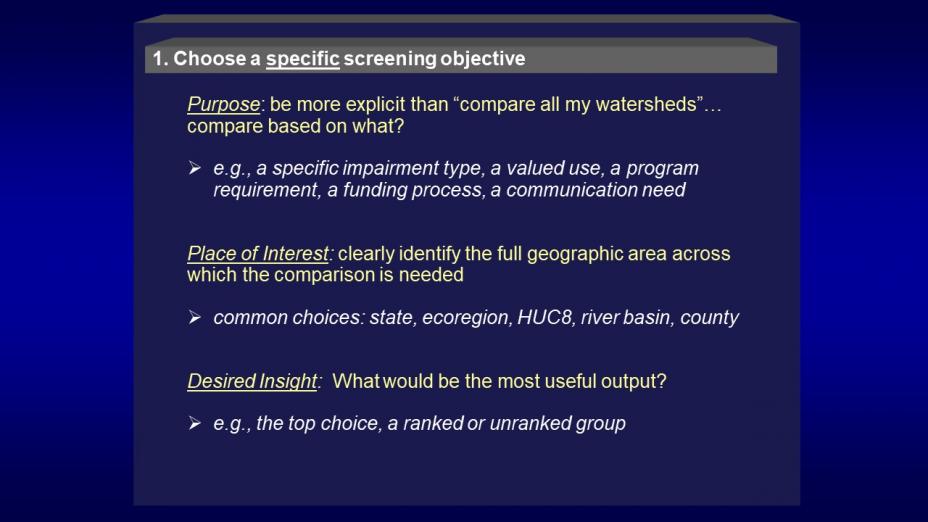Step 1: Choose a Specific Screening Objective
 Although it is always possible to go straight to the RPS Tool and ‘play with the data’ informally, good projects begin with good planning. Getting started requires a clear sense of the screening purpose, key participants, the basis for how watersheds will be compared and the products needed from this comparison. If these elements are clearly addressed in the beginning, the screening will be better targeted, more efficient and less subject to confusion or conflict later on. The following elements are essential:
Although it is always possible to go straight to the RPS Tool and ‘play with the data’ informally, good projects begin with good planning. Getting started requires a clear sense of the screening purpose, key participants, the basis for how watersheds will be compared and the products needed from this comparison. If these elements are clearly addressed in the beginning, the screening will be better targeted, more efficient and less subject to confusion or conflict later on. The following elements are essential:
- Identify the purpose for the screening
- Define the geographic area of interest
- Identify the type of findings and specific products desired
Identify the purpose for the screening
Most users employ Recovery Potential Screening to compare watersheds and identify differences that help inform their actions or decisions. Participants often begin their RPS projects with a non-specific “just compare my watersheds” approach, but the purpose(s) for a screening usually can and should be more narrowly focused. A clear, well-stated objective reveals more about the information that will be needed for a meaningful comparison. As they look closer and discuss the options, users and their workgroups often refine their screening purpose. They may also identify additional purposes for other future screenings. This is a very important part of step 1 and should be given all the time it requires. RPS project planners should consider these factors, at a minimum:
- What statutory program or programs and requirements help define the purpose?
- What if any performance measures or goals help define the purpose?
- What types of information are needed?
- What types of decisions and actions must this information support?
- What are the relevant time frames?
- Will data be available to address more specific purposes of specific participants in the screening?
Defining a clear purpose also helps to reveal who should be involved in the screening. Users who are simply gaining insights for themselves can use the RPS Tool on their desktop and need not involve other participants and roles. One user can do statewide screenings with the RPS Tool easily in an hour or less, but buy-in on findings requires more involvement. For a larger group effort, consider that the participants can fill three basic roles: designers, assessors and appliers. The designers should include people that are essential to defining the scope and purpose, but not necessarily the methods. The assessors should be able to compile and analyze the data, develop the outputs and communicate effectively about them. Key skills for assessors usually include detailed knowledge of the watersheds and problems being assessed, ability to use geospatial data and spreadsheets, and the ability to communicate scientific information to more general audiences. The appliers are the users of screening assessment results and thus also often play an important designer role. Although involving many participants in these roles may seem complicated, broader involvement of others generally increases buy-in and relevance of the RPS results to more stakeholders’ activities.
Define the geographic area of interest
It is crucial to define the entire geographic area within which watersheds will be screened and compared. RPS was first designed and is still often used at whole-state scale, but there is no reason to always screen everything statewide. More often than not, the RPS Tool is effectively used to compare the sub-units of a large watershed (e.g., HUC12s within one HUC8), county, river basin or ecoregion. Further, RPS projects often target a subset of the watersheds scattered throughout a larger area (such as only the cropland-dominated watersheds throughout a large ecoregion, or only the watersheds within a state that contain tribal lands). Screening can take place on any geographic area that contains multiple smaller watershed units, provided that sufficient data are available on those units. Note, however, that comparing just a few watersheds (e.g., less than 15) to one another is not recommended as too small a sample for the relative scoring process used in RPS.
Identify the type of findings and specific products desired
The initial scoping should also clearly describe the intended products of the screening and how these will exemplify your watershed comparison in a useful way. For example, do you wish to identify some proportion of the watersheds with greater recovery potential? Can you quantify the size of the group of watersheds (e.g., top 50%, 10%, 2%; top 5, top 100 watersheds) you would want to target? Is a numerically rank-ordered list desirable, or is a qualifying group of watersheds adequate? Are percentile-based groups appropriate? Further, is your screening tasked to provide a final selection or rank-ordering, or is it expected to identify alternative choices and communicate these to decision-makers? Will you want a single interpretive map, or several maps (or graphs, or rank-ordered lists) showing alternative interpretations? Work back from the desired RPS Tool products to be sure your screening design will get you there.
When you have a firm sense of screening purpose and participants, geographic area of focus, and desired outputs, you are ready to move on to the next step.
